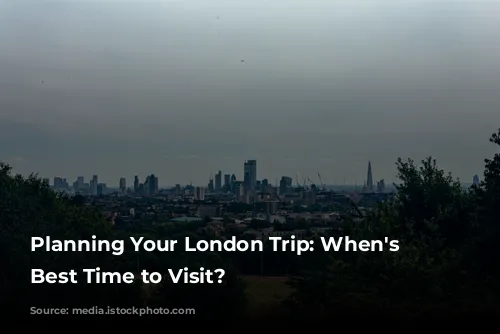London, the vibrant capital of England, draws tourists throughout the year with its captivating history, iconic landmarks, and vibrant cultural scene. But finding the ideal time to visit this bustling city can be a tricky task, depending on your travel preferences. This guide will help you navigate the seasons, understand the crowds, and find the perfect time to experience London’s charm.

Peak Season: When London Comes Alive
From June to August, the city bursts with life as summer unfolds. Temperatures soar to a comfortable 18-30 degrees Celsius , turning London’s lush green spaces into lively oases. Longer daylight hours mean more time to explore iconic landmarks and charming streets, making it a fantastic time for sightseeing. However, peak season brings crowds, especially during July and August when families are on vacation.
December, the season of festive cheer, is equally popular. As the city transforms into a winter wonderland, adorned with twinkling lights, it attracts a multitude of tourists seeking holiday magic. The bustling streets are brimming with shoppers, and the festive spirit is contagious.
Peak season brings a unique charm to London, but it also comes with certain drawbacks. Accommodation and flights are in high demand, so booking in advance is vital. Expect longer queues at attractions and increased prices. While the summer months offer the best weather, they can be humid, and both peak seasons are prone to drizzles.

Shoulder Season: The Perfect Balance of Charm and Affordability
For a more relaxed experience, consider visiting London during the shoulder seasons, from September to November or March to May. These periods offer a delightful compromise between the bustling crowds and the chilly winter months.
Autumn (September-November) sees a gradual decline in crowds after the summer rush. The city comes alive with fall colors, and the air feels crisp and invigorating. However, temperatures start to cool down, and precipitation increases to over 2 inches.
Early spring (March-May) is a time of rebirth. As the city awakens from its winter slumber, the gardens and royal parks burst into bloom, painting London in a colorful palette. Temperatures slowly climb back up to a comfortable 11-15 degrees Celsius, perfect for outdoor activities. While crowds start to pick up again in late spring, they are still manageable compared to the peak season.
Shoulder seasons offer a sweet spot for both budget-conscious travelers and those seeking a more intimate experience. Hotel rates are more affordable, and attractions are less crowded, allowing for a more leisurely pace of exploration. However, be prepared for some inclement weather, especially during the shoulder seasons.

Off-Season: A Unique Perspective on London
January and February, often dubbed the off-season, offer a unique perspective on London. While temperatures drop to a chilly one degree Celsius and heavy rains or snowfall are common, the crowds thin out significantly, creating a sense of tranquility. You’ll find shorter queues at attractions and lower prices on flights and accommodation.
January is particularly enticing for bargain hunters. The New Year sales offer incredible deals on everything from clothing to electronics. However, January is also the coldest month of the year, and daylight hours are reduced. February sees slightly warmer temperatures and a gradual increase in crowds.
Off-season travel requires a bit more flexibility and perhaps a thicker coat. But for those seeking a quieter experience and the best deals, visiting London during the winter months can be an unexpected adventure.

Spring in London: A Symphony of Colors and Festivities
Spring paints London in vibrant colors, as the city awakens from its winter slumber. Temperatures climb to a pleasant 11-15 degrees Celsius, and the gardens and parks explode with blooms. This is the perfect time to stroll through the Royal Parks, admire the colorful blossoms, and enjoy leisurely picnics. The Royal Botanic Gardens at Kew and the Chelsea Flower Show attract visitors from around the globe.
Spring is also a season of festivals and events. Easter, a time of celebration, brings a festive atmosphere to the city, with parades, special events, and traditional meals. St. Patrick’s Day, celebrated with vibrant parades and lively music, adds a touch of Irish charm to the city.
Other popular events include the London Coffee Festival, offering a taste of the city’s thriving coffee culture, and the Virgin Money London Marathon, a thrilling showcase of endurance and athleticism. Museums at Night, a bi-annual event held in May and October-November, allows visitors to explore some of London’s renowned museums after dark.

Summer in London: A Vibrant Blend of Culture and Festivities
Summer in London is a whirlwind of activity, with warm temperatures, long daylight hours, and a vibrant social scene. Temperatures range from 18 to 30 degrees Celsius, making it perfect for outdoor activities. The iconic parks transform into lively gathering spots, and the city’s vibrant nightlife comes alive.
Summer is the time to experience the city’s cultural heartbeat. The annual London Pride parade, a colorful celebration of diversity and inclusion, takes place in June. August brings the vibrant Notting Hill Carnival, a vibrant fusion of music, dance, and Caribbean culture.
Royal enthusiasts can revel in the majesty of Buckingham Palace during its open season, from July to August. The Changing of the Guards ceremony, a time-honored tradition, takes place daily from April to July. The Queen’s birthday parade, known as Trooping the Color, is a spectacular event held in June, showcasing the pomp and ceremony of the British Monarchy.
Summer is also a great time for shopping, with many retailers offering summer sales, including the legendary Harrod’s. Families will appreciate the free transportation offered to children under 11 years old, making it an excellent time for a family vacation.

Winter in London: A Magical Blend of Tradition and Charm
London’s winter season offers a unique blend of festive cheer, cozy charm, and a touch of magic. The city transforms into a winter wonderland, decorated with twinkling lights and embracing the spirit of the holiday season.
December, the month of Christmas and New Year celebrations, is filled with festive cheer. Oxford Street is a shopping haven, while Trafalgar Square is illuminated with a magnificent Christmas tree, creating a magical atmosphere. Theatrical performances, including traditional Christmas pantomimes, add to the festive spirit.
January, despite its chilly temperatures, is an excellent time for bargain hunting. Boxing Day, the day after Christmas, sees huge crowds flocking to shops for the January sales, which continue throughout the first week of the month. The London Parade in January and Pancake Day in February/March add further interest to the winter calendar.
While the winter months may not be ideal for outdoor activities, they offer a chance to explore museums, galleries, and theaters without the usual crowds. The reduced daylight hours allow for a more intimate and cozy experience.
Ultimately, the best time to visit London depends on your priorities. If you’re seeking warm weather and vibrant nightlife, summer is your best bet. Those who prefer a quieter, more intimate experience, and the best deals should consider visiting during the off-season. And if you love the festive spirit and the magic of a winter wonderland, December is the perfect time to experience London’s unique charm.








